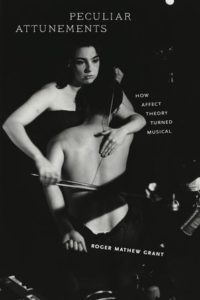by Roger Mathew Grant
The essay begins:
Picture it: East Prussia, autumn, 1814.
 I had been spending some time in the country there, and on quiet nights with moderate winds I used distinctly to hear long, held tones, which would begin to resemble a deep, subdued organ pipe, then also the vibrations from the ringing of a muffled bell. I often could discern precisely the deep F and the striking C a fifth above it, and often even the E-flat a minor third above that also sounded, so that this piercing seventh chord, in the tones of the deepest lamentations, filled my chest with an innermost penetrating melancholy, and even horror.
I had been spending some time in the country there, and on quiet nights with moderate winds I used distinctly to hear long, held tones, which would begin to resemble a deep, subdued organ pipe, then also the vibrations from the ringing of a muffled bell. I often could discern precisely the deep F and the striking C a fifth above it, and often even the E-flat a minor third above that also sounded, so that this piercing seventh chord, in the tones of the deepest lamentations, filled my chest with an innermost penetrating melancholy, and even horror.
These words belong to Lewis, a central character in E. T. A. Hoffmann’s story “Automata.” In this tale, Lewis describes a fantastical encounter with the overtone series, or the “chord of nature,” as it was then called. The sounds of this natural phenomenon overtake him, producing in his body a sympathetic resonance—a sudden, gripping, visceral reaction that he cannot explain.
The critical term for the type of experience Lewis relates is affect. Twenty-first-century theorists describe affect as corporeal, immediate, and nondiscursive. Affect is said to relate conditions of feeling that cannot be adequately captured with the tools of language. Affect theory has recently benefited from a huge resurgence in interest among humanists and social scientists, and whether the apex of this new popularity has already passed or is yet to come, it’s safe to say that affect has not always attracted the attention it does today. As the story typically goes, critics have recently favored affect theory in their search for alternatives to the focus on discourse that characterized the linguistic turn. But this narrative is not exclusive to the twenty-first century; it is also the story of a less well-known movement in intellectual history that occurred in the middle decades of the eighteenth, when debates on music created a fundamental transformation within aesthetic theory.
Affect has a long and rich intellectual heritage, and its relationships to the objects that are said to generate it have been anything but uniform. In early modernity, the affects—or the passions, as they were also called—were important components of an elaborate semiotic system that explained the impact of aesthetic objects. Today, by stark contrast, affect is often explicitly opposed to theories of the sign and of representation; theorists construe affect as a matter of subjective reception that is fundamentally objectless or nonintentional, occasionally even contrasting affect with ideology. The narrative traced in this article draws attention to an earlier moment during which affect was slowly separated from representations of aesthetic objects, and it illustrates the central and surprising role that music played in this separation.
Unfolding two parallel transformations within affect theory’s history, I endeavor to highlight formal features of affect theory that we have been given to repeating. I also aim to draw the history of affect theory into conversation with another, equally vexed archive: the history of music theory. Affective experience and musical sound have created similar problems for theorists. Both are said to act on the body in a material fashion that can be explained with a certain degree of specificity, and yet both are also said to produce transformations within us that exceed and overspill linguistic or rational containment. Music theory and affect theory, I will suggest, have much to teach each other.
Music scholars have not completely neglected the early modern turn to affect within music theory; it used to be called the Affektenlehre, or the “doctrine of affections.” But work on this phenomenon came to a halt in the 1980s, when George Buelow and others decided that its documents contain too many internal contradictions to be considered a cohesive doctrine. Buelow was correct about this, but he underestimated both the importance of those thorny, contradictory treatises and the scope of the intellectual movement they represent. The Affektenlehre was bigger and messier than we had previously thought, and it is now more pertinent to our contemporary discourse than we could ever have imagined. The time has come for a careful reconsideration of this vital and challenging intellectual moment.
In what follows I first elaborate the relationship between affect and the objects that induce it within the classic formulations of Baruch Spinoza and René Descartes. Tracing the lineage of this thought through eighteenth-century aesthetic theory, I demonstrate the crisis that musical tones created in failing to conform to the period’s prevailing aesthetic doctrine of imitation—the perceived failure, that is, of music to imitate any objects or create representations with any regularity. Within the critical quarrels that occurred during this tumultuous period of music theory’s history there emerged a new and much overlooked stage in the Affektenlehre. Certain eighteenth-century music theorists began to posit a mode whereby music aroused affect in listeners through sympathetic resonance. This theory of affective attunement, which reached its fullest elaborations in the writings of German Romantics such as Hoffmann, is closest to our contemporary, corporeal, nondiscursive understanding of affect. Drawing these two moments into conversation, I argue for a refraction of our current thought through earlier models of affect and a renewal of attention to the objects that generate affect in subjects. Continue reading …
This article places the recent turn to affect into conversation with a parallel movement that took place in eighteenth-century music theory. Because theorists in that period struggled to explain how music functioned as a sign, they began to propose an alternative, materialist theory of vibrational attunement in order to account for music’s affective power. By refracting contemporary affect theory through this historical antecedent, the essay argues for renewed attention to the objects in the world that generate affects in subjects.
 Roger Mathew Grant is Associate Professor of Music at Wesleyan University and the author of Beating Time and Measuring Music in the Early Modern Era (Oxford, 2014). He is currently writing a book on the turn to affect within eighteenth-century music theory.
Roger Mathew Grant is Associate Professor of Music at Wesleyan University and the author of Beating Time and Measuring Music in the Early Modern Era (Oxford, 2014). He is currently writing a book on the turn to affect within eighteenth-century music theory.
 Peculiar Attunements: How Affect Theory Turned Musical
Peculiar Attunements: How Affect Theory Turned Musical  Roger Mathew Grant is Associate Professor of Music at Wesleyan University and the author of Beating Time and Measuring Music in the Early Modern Era (Oxford, 2014), which won the 2016 Society for Music Theory Emerging Scholar Award.
Roger Mathew Grant is Associate Professor of Music at Wesleyan University and the author of Beating Time and Measuring Music in the Early Modern Era (Oxford, 2014), which won the 2016 Society for Music Theory Emerging Scholar Award.
 I had been spending some time in the country there, and on quiet nights with moderate winds I used distinctly to hear long, held tones, which would begin to resemble a deep, subdued organ pipe, then also the vibrations from the ringing of a muffled bell. I often could discern precisely the deep F and the striking C a fifth above it, and often even the E-flat a minor third above that also sounded, so that this piercing seventh chord, in the tones of the deepest lamentations, filled my chest with an innermost penetrating melancholy, and even horror.
I had been spending some time in the country there, and on quiet nights with moderate winds I used distinctly to hear long, held tones, which would begin to resemble a deep, subdued organ pipe, then also the vibrations from the ringing of a muffled bell. I often could discern precisely the deep F and the striking C a fifth above it, and often even the E-flat a minor third above that also sounded, so that this piercing seventh chord, in the tones of the deepest lamentations, filled my chest with an innermost penetrating melancholy, and even horror.